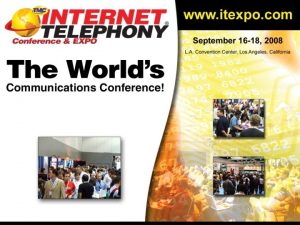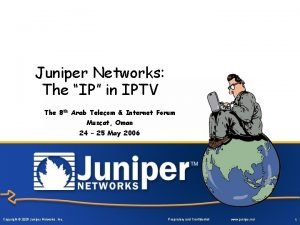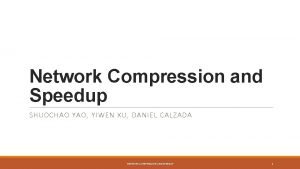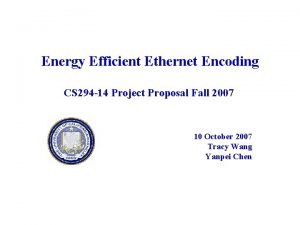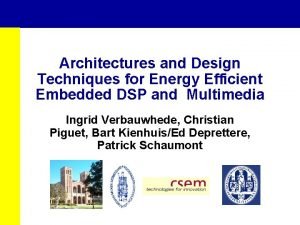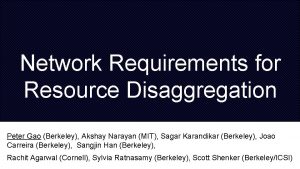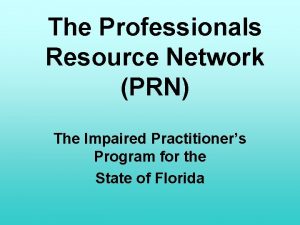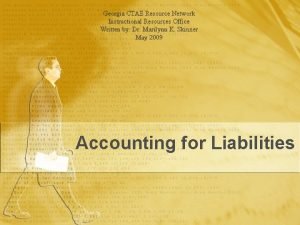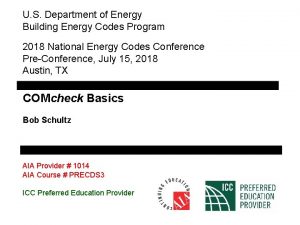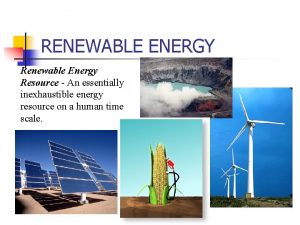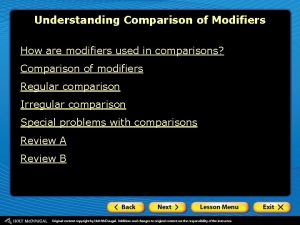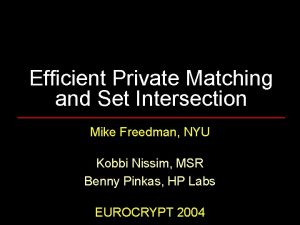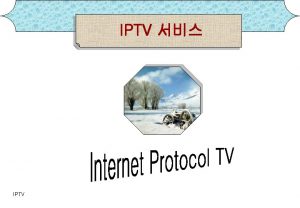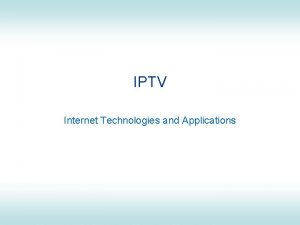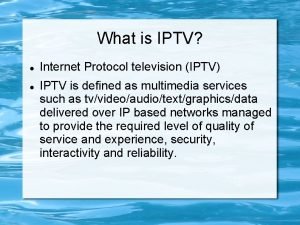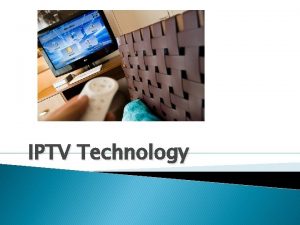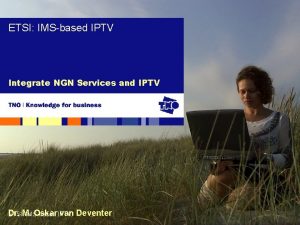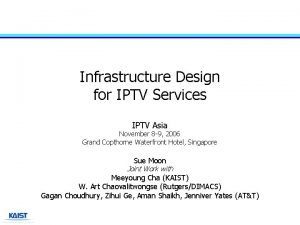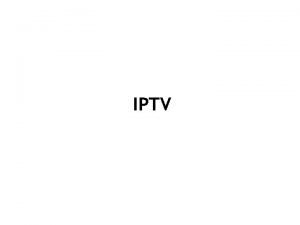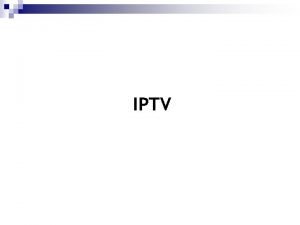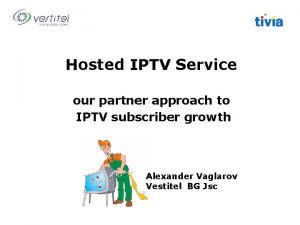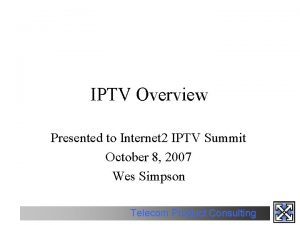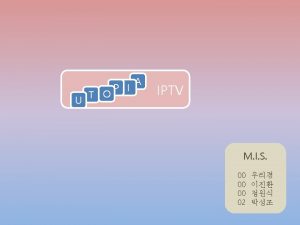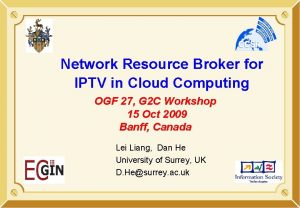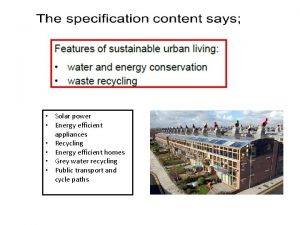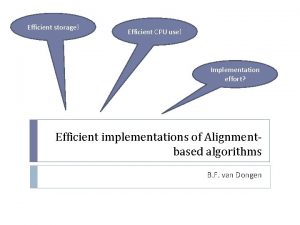GREEN IPTV A Resource and Energy Efficient Network








































![References [Cisco] Cisco visual networking index: Forecast and methodology 2008 -2013, 2008. [Piper] B. References [Cisco] Cisco visual networking index: Forecast and methodology 2008 -2013, 2008. [Piper] B.](https://slidetodoc.com/presentation_image_h/c254773c3c6c45827818e738d4c80fa9/image-41.jpg)
- Slides: 41

GREEN IPTV A Resource and Energy Efficient Network for IPTV

Main objectives of this lecture General Illustrate the usual route taken to make good computer science research Specific Exemplify with a resource and energy efficient network for IPTV

Outline • Route to make good computer science research • IPTV today • Research example 1: resource and energy consumption in IPTV • Research example 2: zapping delay in IPTV • Take-home message

Outline • Route to make good computer science research • IPTV today • Research example 1: resource and energy consumption in IPTV • Research example 2: zapping delay in IPTV • Take-home message

1. Look for an opportunity

2. Identify a problem

3. Analyse state of the art

4. Propose solution

5. Evaluate solution

6. Assess relevance

Outline • Route to make good computer science research • IPTV today • Research example 1: resource and energy consumption in IPTV • Research example 2: zapping delay in IPTV • Take-home message

What is IPTV?

A typical IPTV network Internet IP Network TV Head End Customer Premises TV. . . STB DSLAM PC

More details • All TV channels transmitted always everywhere • IP multicast used – PIM-SM – Static multicast trees – No traffic engineering

Outline • Route to make good computer science research • IPTV today • Research example 1: resource and energy consumption in IPTV • Research example 2: zapping delay in IPTV • Take-home message

Why IPTV? • New service on top of an IP network – Still an infant: around 5 years old • The sum of all forms of video (IPTV, Vo. D, P 2 P) will account for over 91% of global consumer traffic by 2013 [Cisco] • In the US there already more than 5 million subscribers, and this number is expected to increase to 15. 5 million by 2013 [Piper] 1. opportunities 2. problem 3. state of the art 4. solution 5. evaluation 6. relevance

Resource inefficiencies • 90% of all TV viewing is restricted to a small selection of channels [Cha et al. ][Qiu et al. ] 160 140 metro/core Number of channels 120 100 80 access 60 Channels with viewers 40 Channels broadcasted 20 0 10 1. opportunities 2. problem 1000 Number of users 3. state of the art 10000 4. solution 100000 5. evaluation 6. relevance

Selective pre-fetching of TV channels • Instead of each node pre-fetching all TV channels, pre-fetch only a selection of channels • Pre-fetch active channels (channels for which there are viewers) + a small number of inactive channels • Room size = number of inactive channels prefetched 1. opportunities 2. problem 3. state of the art 4. solution 5. evaluation 6. relevance

Trace-driven simulation • Using huge dataset from a nationwide IPTV provider: – 255 k users, 6 months, 150 TV channels, 622 DSLAMs, 11 regions 1. opportunities 2. problem 3. state of the art 4. solution 5. evaluation 6. relevance

Results – bandwidth savings Number of channels prejoined 160 140 120 50% bandwidth reduction 33% bandwidth reduction 100 80 60 40 20 0 r=5 r = 10 r = 15 r = 20 r = 25 r=0 All (access) (access) (metro) channels 1. opportunities 2. problem 3. state of the art 4. solution 5. evaluation 6. relevance

Results – requests affected 16% 14% < 2% requests affected % of requests 12% 10% < 0. 1% requests affected 8% 6% 4% 2% 0% r=0 r=5 r = 10 r = 15 r = 20 r = 25 r=0 All (access) (access) (metro) channels 1. opportunities 2. problem 3. state of the art 4. solution 5. evaluation 6. relevance

Is it worth it? Conclusion Today probably not, in the future probably yes 1. opportunities 2. problem 3. state of the art 4. solution 5. evaluation 6. relevance

What about energy savings?

Router power consumption model Max power Power consumption Dp Dl Max capacity Load • We assume the router can turn off ports not in use • Δl and Δp based on real measurements [Chabarek et al. ] • 250 edge routers + 50 core routers 1. opportunities 2. problem 3. state of the art 4. solution 5. evaluation 6. relevance

3. 0 € 500 Thousands € 450 2. 5 € 400 cost savings (€) € 350 2. 0 energy savings(k. Wh) € 300 1. 5 € 250 € 200 1. 0 € 150 € 100 0. 5 Cost savings per year Energy savings per year Millions Is it worth it? (2) € 50 0. 0 € 0 today 2 -4 years 10 -15 years Conclusion Today not, in the future maybe 1. opportunities 2. problem 3. state of the art 4. solution 5. evaluation 6. relevance

Outline • Route to make good computer science research • IPTV today • Research example 1: resource and energy consumption in IPTV • Research example 2: zapping delay in IPTV • Take-home message

Zapping delay • In IPTV this delay can add up to two seconds or more – should be below 430 ms[Kooji et al. ] 1. opportunities 2. problem 3. state of the art 4. solution 5. evaluation 6. relevance

Several solutions proposed • Video coding and processing techniques • Network level • Problems of existing solutions: – Complexity – Additional video servers needed 1. opportunities 2. problem 3. state of the art 4. solution 5. evaluation 6. relevance

Most zapping is linear. . . 1. opportunities 2. problem 3. state of the art 4. solution 5. evaluation 6. relevance

IPTV today IPTV NETWORK Requesting channel 3 1. opportunities 2. problem Sending channel 3 3. state of the art 4. solution 5. evaluation 6. relevance

IPTV with channel smurfing IPTV NETWORK Requesting channel 3 1. opportunities 2. problem Requesting channel 2, 3, 4 3. state of the art Sending channel 2, 3, 4 4. solution 5. evaluation 6. relevance

Channel smurfing • Besides the channel requested, send N neighbouring channels concurrently for C seconds. 1. opportunities 2. problem 3. state of the art 4. solution 5. evaluation 6. relevance

Trace-driven simulation • Using huge dataset from a nationwide IPTV provider: – 255 k users, 6 months, 150 TV channels, 622 DSLAMs, 11 regions 1. opportunities 2. problem 3. state of the art 4. solution 5. evaluation 6. relevance

Results – requests with no delay % of switching requests with no delay 100% 80% 60% 40% 2 neighbours 4 neighbours 20% 6 neighbours 0% 10 seconds 30 seconds 1 minute 2 minutes Always 8 neighbours 10 neighbours -20% ideal predictor -40% -60% -80% 1. opportunities 2. problem Concurrent channel time 3. state of the art 4. solution 5. evaluation 6. relevance

Results – requests with no delay (zapping periods only) % of switching requests with no delay 100% 80% 60% 40% 2 neighbours 4 neighbours 20% 6 neighbours 0% 10 seconds 30 seconds 1 minute 8 neighbours 10 neighbours -20% ideal predictor -40% -60% -80% 1. opportunities 2. problem Concurrent channel time 3. state of the art 4. solution 5. evaluation 6. relevance

Results – average bandwidth Average bandwidth consumption (Mbps) 40 35 30 25 2 neighbours 4 neighbours 20 6 neighbours 8 neighbours 15 10 neighbours ideal predictor 10 5 0 10 seconds 30 seconds 1. opportunities 2. problem 1 minute 2 minutes Concurrent channel time 3. state of the art 4. solution Always 5. evaluation 6. relevance

Is it worth it? • Very simple to implement Distance to ideal predictor – Small software upgrade – No additional video servers needed – Performance close to optimal predictor 45% 40% 35% 30% 2 neighbours 25% 4 neighbours 20% 6 neighbours 15% 8 neighbours 10% 10 neighbours 5% 0% 10 seconds 1. opportunities 2. problem 30 seconds 1 minute 2 minutes Concorrent channel time 3. state of the art Always 4. solution 5. evaluation 6. relevance

Outline • Route to make good computer science research • IPTV today • Research example 1: resource and energy consumption in IPTV • Research example 2: zapping delay in IPTV • Take-home message

Take-home message 1. Computer science knowledge can be used in novel, practical, useful ways 2. It is important to build realistic scenarios to evaluate our ideas 3. It is fundamental to accept that any technical solution has limitations and that these should not be concealed 4. Be aware that a solution to a problem is only relevant if the benefits clearly outweigh the disadvantages

Interested in these matters? Any idea what the “G” in GREEN could stand for? Feel free to contact me: fernando. ramos@cl. cam. ac. uk
![References Cisco Cisco visual networking index Forecast and methodology 2008 2013 2008 Piper B References [Cisco] Cisco visual networking index: Forecast and methodology 2008 -2013, 2008. [Piper] B.](https://slidetodoc.com/presentation_image_h/c254773c3c6c45827818e738d4c80fa9/image-41.jpg)
References [Cisco] Cisco visual networking index: Forecast and methodology 2008 -2013, 2008. [Piper] B. Piper. United states IPTV market sizing: 2009 -2013. Technical report, Strategy Analytics, 2009. [Cha et al. ] M. Cha, P. Rodriguez, J. Crowcroft, S. Moon, and X. Amatriain. Watching television over an IP network. In Proc. ACM IMC, 2008. [Qiu et al. ] T. Qiu, Z. Ge, S. Lee, J. Wang, Q. Zhao, and J. Xu. Modeling channel popularity dynamics in a large IPTV system. In Proc. ACM SIGMETRICS, 2009. [Chabarek et al. ] J. Chabarek, J. Sommers, P. Barford, C. Estan, D. Tsiang, and S. Wright. Power awareness in network design and routing. In Proc. IEEE INFOCOM, 2008. [Kooji et al. ] R. Kooij, K. Ahmed, K. Brunnstr¨om, and K. Acreo. Perceived quality of channel zapping. In proceedings of the IASTED , 2006.
 Productively efficient vs allocatively efficient
Productively efficient vs allocatively efficient Allocative efficiency
Allocative efficiency Productively efficient vs allocatively efficient
Productively efficient vs allocatively efficient Productively efficient vs allocatively efficient
Productively efficient vs allocatively efficient Productive inefficiency and allocative inefficiency
Productive inefficiency and allocative inefficiency Red green show
Red green show Green iptv
Green iptv Walker-iptv
Walker-iptv Iptv network architecture
Iptv network architecture Shuochao yao
Shuochao yao Energy energy transfer and general energy analysis
Energy energy transfer and general energy analysis Energy energy transfer and general energy analysis
Energy energy transfer and general energy analysis Sankey diagram of light bulb
Sankey diagram of light bulb Energy efficient construction
Energy efficient construction Intel energy efficient ethernet
Intel energy efficient ethernet Energy-efficient embedded systems
Energy-efficient embedded systems Resource leveling is the approach to even out the peaks of
Resource leveling is the approach to even out the peaks of Perbedaan resource loading dan resource levelling
Perbedaan resource loading dan resource levelling Lernpyramide von green & green (2005)
Lernpyramide von green & green (2005) Green yellow red blue
Green yellow red blue Frc driver station mac
Frc driver station mac Network requirements for resource disaggregation
Network requirements for resource disaggregation Arcnet
Arcnet Impaired practitioner program florida
Impaired practitioner program florida Ctae resource network worksheets answers
Ctae resource network worksheets answers Ctae resource network
Ctae resource network Ctae resource network
Ctae resource network Comcheck
Comcheck Meaning of renewable resource
Meaning of renewable resource Renewable energy sources are essentially inexhaustible
Renewable energy sources are essentially inexhaustible Difference between datagram and virtual circuit operation
Difference between datagram and virtual circuit operation Features of peer to peer network and client server network
Features of peer to peer network and client server network Network centric computing and network centric content
Network centric computing and network centric content Brad verter
Brad verter Green learning network
Green learning network Effectiveness and efficiency example
Effectiveness and efficiency example Examples of explicit instruction
Examples of explicit instruction Using the body in an efficient and careful way is
Using the body in an efficient and careful way is Comparative forms and modifiers
Comparative forms and modifiers Efficient private matching and set intersection
Efficient private matching and set intersection Efficient capital markets and behavioral challenges
Efficient capital markets and behavioral challenges Efficient and equitable taxation
Efficient and equitable taxation







